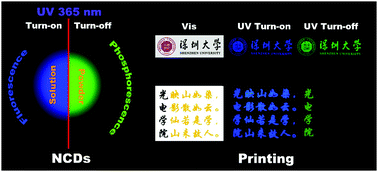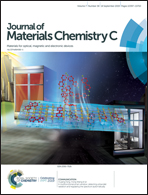The design of room-temperature-phosphorescent carbon dots and their application as a security ink†
Abstract
Room temperature phosphorescent (RTP) carbon dots have attracted considerable interest due to their fundamental importance and potential applications in optoelectronic devices, sensing, bioimaging and document security. The preparation method of RTP carbon dots is based on the formation of the C![[double bond, length as m-dash]](https://www.rsc.org/images/entities/char_e001.gif) N (or C
N (or C![[double bond, length as m-dash]](https://www.rsc.org/images/entities/char_e001.gif) O) groups and hydrogen bond. Herein, we have added acrylamide in the reaction system to form hydrogen bonds and stabilize the triplet excitons. Thus, the nontoxic RTP carbon dots (NCDs) were designed and prepared via a one-step hydrothermal method. The nitrogen element (N) in the NCDs can effectively increase their fluorescence intensity, while the produced C
O) groups and hydrogen bond. Herein, we have added acrylamide in the reaction system to form hydrogen bonds and stabilize the triplet excitons. Thus, the nontoxic RTP carbon dots (NCDs) were designed and prepared via a one-step hydrothermal method. The nitrogen element (N) in the NCDs can effectively increase their fluorescence intensity, while the produced C![[double bond, length as m-dash]](https://www.rsc.org/images/entities/char_e001.gif) N bonds promote the formation of triplet excitons. More importantly, the acrylic amide and the as-generated polyacrylamide (PAM) on the surface of NCDs could easily connect with the as-prepared pyridinic N via the reaction between citric acid and urea, and formed the hydrogen bond that could stablilize the triplet excitons. Hence, NCDs exhibit stable phosphorescence properties. We further show the promising application of the as-prepared aqueous NCDs as a new smart concealed and potential security ink.
N bonds promote the formation of triplet excitons. More importantly, the acrylic amide and the as-generated polyacrylamide (PAM) on the surface of NCDs could easily connect with the as-prepared pyridinic N via the reaction between citric acid and urea, and formed the hydrogen bond that could stablilize the triplet excitons. Hence, NCDs exhibit stable phosphorescence properties. We further show the promising application of the as-prepared aqueous NCDs as a new smart concealed and potential security ink.



 Please wait while we load your content...
Please wait while we load your content...